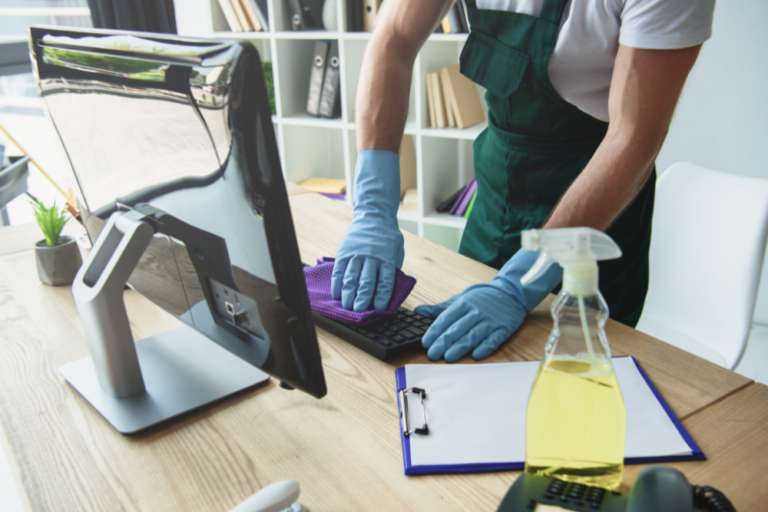
How to Plan a Commercial Property Cleanout
August 25, 2025
Why Every Restaurant Needs Regular Junk Removal
August 25, 2025Tips for Handling Office Junk During a Business Transition
Navigating the complexities of a business transition often involves more than just shifting operations—it requires a meticulous approach to decluttering and managing office junk. Whether you’re relocating, renovating, or rebranding, effectively handling unwanted items is crucial for maintaining productivity and morale. Here’s a comprehensive guide to managing office junk during such transitions.
Assessing Your Office Inventory
Before diving into the removal process, take a systematic inventory of your office items. Walk through each department, noting furniture, equipment, and supplies that are outdated, unused, or no longer serve their purpose. This assessment helps in categorizing items for disposal, donation, recycling, or reuse, ensuring that only necessary items are moved to the new location.
Engaging employees in this process can provide valuable insights. They can identify items that are no longer functional or needed, and their involvement fosters a sense of ownership and responsibility. Clear labeling and documentation during this phase will streamline the subsequent steps and minimize confusion.

Categorizing Items for Disposal
Once the inventory is complete, categorize the items into distinct groups: those to keep, donate, recycle, or dispose of. This classification aids in making informed decisions about each item’s fate. For instance, old electronics may require special disposal methods due to environmental regulations, while gently used furniture could be donated to local charities.
Establishing a timeline for each category ensures that items are addressed promptly. Set deadlines for donations, schedule recycling pickups, and arrange for disposal services. This structured approach prevents items from lingering unnecessarily and keeps the transition on track.
Implementing a Decluttering Schedule
A well-planned decluttering schedule is essential to avoid overwhelming your team and disrupting daily operations. Break down the process into manageable tasks, assigning specific days or times for different departments or areas. This phased approach allows for continuous workflow while gradually reducing clutter.
Communicate the schedule clearly to all employees, emphasizing the importance of their participation. Encourage them to sort through their personal workspaces and communal areas, ensuring that all unwanted items are addressed. Regular check-ins can help maintain momentum and address any challenges promptly.
Engaging Professional Junk Removal Services
While internal efforts are valuable, professional junk removal services can significantly expedite the process. These experts have the necessary equipment and experience to handle large volumes of items efficiently and safely. They can also ensure that items are disposed of in compliance with local regulations, particularly concerning hazardous materials.
Collaborate with the junk removal team to establish a timeline that aligns with your business’s schedule. Provide them with the categorized list of items and any specific instructions regarding sensitive materials. Their expertise can alleviate the burden on your staff and facilitate a smoother transition.
Recycling and Sustainable Disposal Practices
Incorporating sustainable practices into your junk removal process not only benefits the environment but also enhances your company’s reputation. Identify items that can be recycled, such as paper, cardboard, and certain plastics. Partner with certified recycling centers to ensure proper processing.
For electronics, seek out e-waste recycling programs that adhere to environmental standards. Avoid sending such items to landfills, as they can release harmful substances into the environment. Promoting sustainability during your business transition reflects corporate responsibility and can positively impact stakeholder perceptions.
Donating Usable Items to Charities
Instead of discarding usable office furniture, equipment, or supplies, consider donating them to local charities or non-profit organizations. Many groups welcome such contributions, which can be tax-deductible for your business. This practice not only supports the community but also reduces the volume of waste generated during the transition.
Coordinate with the receiving organizations to arrange for pickup or delivery of the items. Ensure that all donations are in good condition and meet the needs of the recipients. Document the donations for record-keeping and potential tax purposes.
Handling Sensitive and Confidential Materials
During a business transition, it’s imperative to manage sensitive and confidential materials with the utmost care. This includes personal employee information, financial records, and proprietary business documents. Implement a secure shredding process to destroy paper documents and ensure that electronic data is wiped clean from devices before disposal.
Engage with certified data destruction services to handle electronic waste. These professionals follow strict protocols to prevent data breaches and comply with legal requirements. Prioritizing data security protects your business from potential liabilities and maintains trust with clients and employees.
Managing Large and Bulky Items
Large office furniture, such as desks, filing cabinets, and shelving units, can pose challenges during a business transition. Dismantling these items may be necessary to facilitate their removal. Ensure that your team is equipped with the proper tools and knowledge to safely disassemble and transport these bulky items.
If dismantling in-house isn’t feasible, consider hiring professionals who specialize in handling large furniture. They can efficiently manage the disassembly and removal process, minimizing disruption to your operations. Proper handling of these items prevents damage to your property and ensures a safe working environment.
Coordinating with Moving and Renovation Teams
If your business transition involves relocating or renovating, coordinate closely with moving and renovation teams to align schedules and responsibilities. Provide them with the inventory list and categorized items to ensure that only necessary items are moved or stored.
Establish clear communication channels to address any issues that may arise during the transition. Regular meetings or updates can help keep all parties informed and on track. A collaborative approach ensures that the transition progresses smoothly and that all aspects are managed effectively.
Communicating with Employees and Stakeholders
Transparent communication with employees and stakeholders is crucial throughout the business transition process. Keep them informed about the timeline, expectations, and any changes that may affect their roles or responsibilities. Address concerns promptly and provide support as needed.
Encourage feedback and suggestions from employees to improve the transition process. Their insights can offer valuable perspectives and help identify potential issues early. Fostering an open dialogue promotes a positive atmosphere and facilitates a more successful transition.
Conclusion
Handling office junk during a business transition requires careful planning, organization, and collaboration. By assessing your inventory, categorizing items, implementing a decluttering schedule, and engaging professional services, you can ensure a smooth and efficient process. Prioritizing sustainability, data security, and clear communication further enhances the transition experience.
For businesses in Santa Rosa, CA, and the surrounding North Bay area, North Bay Junk Removal offers comprehensive junk removal services tailored to your needs. Whether you’re undergoing an office cleanout, renovation, or relocation, their professional team is equipped to handle the task efficiently and responsibly. Contact them at 707-478-6817 to schedule a consultation and take the first step toward a clutter-free workspace.




